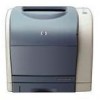HP 2500 HP PCL/PJL reference - Printer Job Language Technical Reference Manual - Page 5
Inside This Manual, What You Can Learn From This Manual, Application Developers - switch
 |
View all HP 2500 manuals
Add to My Manuals
Save this manual to your list of manuals |
Page 5 highlights
Inside This Manual What You Can Learn From This Manual Printer Job Language (PJL) was developed by Hewlett-Packard to provide a method for switching printer languages at the job level, and for status readback between the printer and the host computer. PJL offers application programs an efficient way to remotely control Hewlett-Packard printers. Using PJL, developers can provide applications with the ability to programmatically switch printer languages, monitor printer status, request the printer model and configuration, change control panel default settings, modify control panel messages, and more. This manual is written for experienced users such as application developers and technical support personnel. Before using PJL commands, programmers should be familiar with the introductory information in Chapters 1, 2, and 3, and with the programming tips in Chapter 11. In addition, users of this manual should be acquainted with the HP LaserJet printer language (PCL) and with LaserJet printer features. Application Developers This PJL Technical Reference Manual provides developers with all the information necessary to add PJL to their applications. Examples are used throughout the manual to help developers write efficient and properly functioning code. Technical Support Personnel This manual provides reference information for network administrators and other technical support personnel who manage multi-user systems. PJL provides the potential for significantly enhancing network printer operation. Non-Technical Users Non-technical users can use the features of PJL by using HP Explorer Software, or by using software that supports PJL. Since improperly used PJL commands can cause problems in a network situation, inexperienced users are advised against using PJL commands on any system other than a dedicated workstation. EN iii














